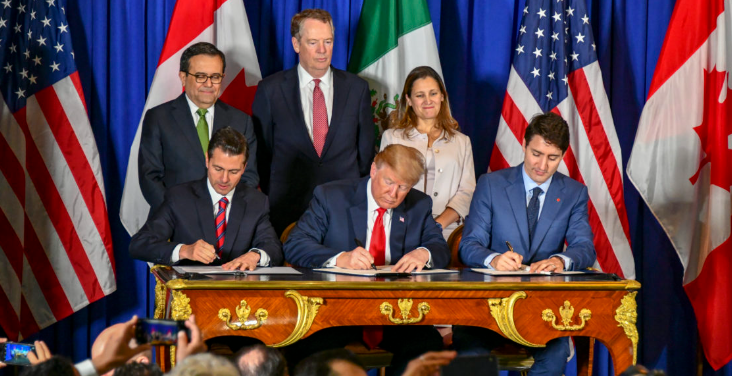Mexico: How Far Have its Institutions Really Come?
The question remains if Mexico has achieved a degree of institutional development consistent with its participation in those organizations.
A Daily Publication of The Dialogue
The United States-Mexico-Canada Agreement (USMCA) is up for review in July 2026, at which time any of the three countries can opt not to renew the trade accord, an action that would put its future into question. The upcoming review makes 2024 a critical year for the future of the USMCA, as both Mexico and the United States will have presidential elections, and the priorities of the countries’ leaders will determine the future of the trade deal. What are the most important parts of the USMCA review process? How do the Mexican and U.S. presidential candidates view the agreement, and what actions are likely given who is elected in the two countries? What’s at stake in the elections for businesses that are affected by the USMCA?
Lucinda Vargas, associate director of the Center for Border Economic Development at New Mexico State University: “The USMCA is unique among trade agreements in having established a review process. While trade agreements stipulate a time horizon within which their implementation is to take place (15 years in NAFTA’s case), they are intended to last indefinitely. This ensures that an agreement’s new ‘rules of the game’ will remain, thus providing certainty for investors. Indeed, provisions for amending trade agreements and even for withdrawing from them are standard in such treaties, preempting the need for any required review process. The USMCA’s review clause, embedded in the agreement at the behest of the United States, therefore serves more the purpose of bringing the players to the table in a political test of wills on how, and even whether, to continue the agreement per any unfavorable assessment of the treaty, and even of the players, up to that point. Donald Trump is very good at this game. If he’s the next U.S. president, China’s connection with Mexico will certainly be on his mind, as it will be on Biden’s if elected. While Mexico in 2023 supplanted China as the top exporter to the United States, China itself has deepened its investment presence in Mexico as a gateway to export to the United States under the auspices of the USMCA. This back-door Chinese access to the U.S. market is already causing a stir in Washington, but can the United States impose on Mexico which countries can and cannot invest in its export sector for USMCA privileges to apply? Mexico’s answer would be a resounding no, regardless of who is its next president.”
Diego Marroquín Bitar, inaugural Bersin-Foster North America Scholar at the Wilson Center: “With the approaching review of the USMCA, national elections in Canada, Mexico and the United States before 2026 add an element of uncertainty. Regardless of election outcomes, Mexico and Canada are likely to defend the status quo and advocate for adherence to a 493-day old panel decision that deemed the U.S. interpretation of Regional Value Content (RVC) in the auto sector inconsistent with the USMCA. In contrast, a Democratic or Republican administration will likely pursue an offensive strategy aimed at enforcing stricter trade rules and raising the barriers to direct and indirect Chinese exports and investment. The former approach would safeguard the USMCA’s double-digit growth in cross-border trade since 2020 and bolster the 17 million North American jobs that rely on intra-regional exports. However, this approach risks missing the opportunity to align the agreement with a rapidly evolving global economy and losing more markets to China. The latter could help update the agreement but would jeopardize the region’s competitiveness by potentially increasing costs to a level where companies downgrade integration efforts and preferential market access under the USMCA over World Trade Organization tariffs. The existing confusion regarding RVC in autos is only one of several areas to be addressed. Unless all countries confirm in writing that they want to continue the agreement, the USMCA is set to expire in 2036. An unsuccessful review in 2026 will not necessarily end North American trade as we know it, but it could trigger a painful series of yearly joint reviews capable of undermining long-term investments and stymying job growth. Thus, a competitive North America should be able to play both offense and defense.”
Turenna Ramirez Ortiz, partner at Holland & Knight: “In accordance with article 34.7 of the USMCA review, this is a ‘joint revision of the parties,’ so it’s important to note that this is not a renegotiation. This review is intended to analyze its efficiency, consider recommendations, decide on appropriate adjustments and, most importantly, the continuance of the USMCA. Two scenarios could happen during the joint review. First, if each party confirms its desire to extend this agreement, it shall be automatically extended for 16 years. Or, second, if, as part of a six-year review, one or more parties doesn’t confirm its desire to extend the term, the commission shall meet to conduct a joint review each year until 2036, and at any time between the conclusion of the review and the expiration of the agreement, the parties may automatically extend the term by heads of government confirming it in writing. Additionally, presidential candidates of both countries view the USMCA as a relevant instrument for trade and economic development. However, candidates may use this revision as a political instrument to protect each country’s interests. Topics that may arise include the rules of origin for electric vehicles and batteries. Also, disputes over energy and labor will be decisive no matter which candidate is elected. Investor confidence, respect for the rule of law and the continuation of investments in the region will be affected by the USMCA. The USMCA is considered a legal ‘safety net’ for current and new businesses managing cost-efficient operations, so not having the agreement may discourage new business development.”
Dan Ciuriak, senior fellow at the Centre for International Governance Innovation in Waterloo, Ontario:“The politics of trade has been almost poisonous for the past decade. The WTO is effectively side-lined and regional trade agreements have backpedaled, as highlighted by the negative quantitative assessments of the USMCA compared to NAFTA, and of course, Brexit. Also, the trade share of global GDP has stopped rising, seemingly ratifying the critique that globalization went too far. From a political perspective, the prospects for North American trade are certainly not rosy. Biden and Trump have been on the same page on trade, Canada renamed its trade minister the minister for trade diversification and Mexico will likely continue to ‘look south’ under López Obrador’s successor, Claudia Sheinbaum. The era of ‘three amigos’ is long gone. Yet, neither Canada nor Mexico have diversified their exports away from North America, despite the USMCA headwinds. Additionally, the flattening out of global trade relative to GDP is more plausibly attributed to the technological advances in the 2010s—advanced manufacturing, 3D printing and data-driven automation in general—than to trade politics. Perhaps most importantly, the global and regional value chains forged over decades of adaptation to continental free trade and the ‘made in the world’ system under the WTO appear to reflect a deep-seated rationalization and optimization of production systems that is robust to the (relatively) shallow effect of supply chain politics and nationalist industrial policies. Ultimately, it is companies that trade, not countries, and perhaps that is the best basis for optimism about the future of North American trade under the coming political transition.”
 The Latin America Advisor features Q&A from leaders in politics, economics, and finance every business day. It is available to members of the Dialogue’s Corporate Program and others by subscription.
The Latin America Advisor features Q&A from leaders in politics, economics, and finance every business day. It is available to members of the Dialogue’s Corporate Program and others by subscription.
The question remains if Mexico has achieved a degree of institutional development consistent with its participation in those organizations.
Focusing on transnational crime is a top priority of the Obama administration’s policy in Latin America.
Despite reports in recent months that Mexican manufacturing is experiencing a resurgence, Mexico’s industrial sector faces tremendous challenges.
 Upcoming elections this year could affect the USMCA trade deal. Then-Presidents Enrique
Peña Nieto of Mexico and Donald Trump of the United States, as well as Canadian Prime Minister Justin Trudeau are pictured signing the accord in 2018.
Upcoming elections this year could affect the USMCA trade deal. Then-Presidents Enrique
Peña Nieto of Mexico and Donald Trump of the United States, as well as Canadian Prime Minister Justin Trudeau are pictured signing the accord in 2018.